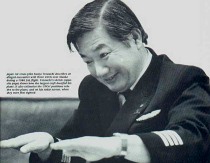Article/Document:
When Pilots See UFOs
Dennis Stacy, Air & Space Magazine, December 1987/January
original source | fair use notice
Summary: People have been seeing unidentified flying objects in the skies for years. But when the eyewitness is up there with the UFO, is the sighting more difficult to explain? (This article refers mainly to the Japan Airlines Flight 1628 UFO case.)
People have been seeing unidentified flying objects in the skies for years. But when the eyewitness is up there with the UFO, is the sighting more difficult to explain?
In the late afternoon of November 17, 1986, Japan Air Lines flight 1628, a Boeing 747 with a crew of three, was nearing the end of a trip from Iceland to Anchorage, Alaska. The jet, carrying a cargo of French wine, was flying at 35,000 feet through darkening skies, a red glow from the setting sun lighting one horizon and a full moon rising above the other.
A little after six p.m., pilot Kenju Terauchi noticed white and yellow lights ahead, below, and to the left of his airplane. He could see no details in the darkness and assumed the lights were those of military aircraft. But they continued to pace the 747, prompting first officer Takanori Tamefuji to radio Anchorage air traffic control and ask if there were other aircraft nearby. Both Anchorage and a nearby military radar station announced that they were picking up weak signals from the 747's vicinity. Terauchi switched on the digital color cockpit weather radar, which is designed to detect weather systems, not other aircraft. His radar screen displayed a green target, a color usually associated with light rain, not the red he would have expected from a reflective solid object.
Because he was sitting in the left-hand seat, Terauchi had the only unob- structed view when the lights, still in front of and below the airplane, began moving erratically, "like two bear cubs playing with each other," as the pilot later wrote in a statement for the Federal Aviation Administration. After several minutes, the lights suddenly darted in front of the 747, "shooting off lights" that lit the cockpit with a warm glow.
As the airplane passed over Eielson Air Force Base, near Fairbanks, the captain said he noticed, looming behind his airplane, the dark silhouette of a gigantic "mothership" larger than two aircraft carriers. He asked air traffic control for permission to take his airplane around in a complete circle and then descend to 31,000 feet. Terauchi said his shadower followed him through both maneuvers.
A United Airlines fight and a military C-130 were both in the area and An- chorage asked the airplanes to change course, intercept the Japanese 747, and confirm the sighting. Both airplanes flew close enough to see JAL 1628's navigation lights, alone in the night sky, before Terauchi reported that the unidentified flying objects had disappeared. The encounter had lasted nearly 50 minutes.
Because it involved an airline pilot and an unidentified flying object that had apparently been captured on radar, the JAL 1628 encounter attracted a great deal of public attention. But UFO reports from pilots--private, military and airline--are not new to the subject of "ufology." One of the best known cases was a sighting by Idaho businessman and private pilot Kenneth Arnold. Flying his single-engine airplane over Washington's Cascade Mountains on June 24, 1947, Arnold spotted nine silvery, crescent-shaped objects skimming along at high speed near Mt. Rainier. They dipped as they flew, "like a saucer would if you skipped it across water," Arnold told reporters--and thus "flying saucers" entered the popular vocabulary.
Pilots had reported similar unexplained aerial phenomena before, mainly in the form of the "Foo Fighters" noted by American bomber crews over Europe in World War II. But Arnold's sighting, with its accompanying front-page publicity, struck a jittery, post-Hiroshima nerve in American society and set off a barrage of similar reports. Skeptics believed that every sighting had a prosaic explanation, such as mis-identification of stars, planets, or natural atmospheric phenomena. Others thought that there was more to UFOs, that they could even be visitors from other planets.
Following the Arnold incident, the Air Force was given the responsibility of investigating UFO reports from the United States, first as Project Sign (also called Saucer), then Grudge, and finally Blue Book. Usually understaffed and underfunded, the Air Force program functioned more like a public relations office than a scientific investigation, according to the late astronomer J. Allen Hynek. Hynek himself, who served as a consultant to Project Blue Book from 1948 until it was dissolved in December 1969, gradually changed from a skeptic into a believer.
Not even skeptics can deny the subject's popular appeal. Last March, a Gallop poll found that 88 percent of its respondents had heard of UFOs. Nearly half of those polled believed UFOs were real, not figments of the imagination or mis-perceived natural phenomena. Nine percent of the adult population claimed to have seen one.
Of these claims, pilot reports are the ones that interest Richard F. Haines, a perceptual psychologist who compiles AIRCAT, a computerized catalog that lists more than 3,000 UFO sightings by aviators over the past 40 years. Chief of the Space Human Factors Office at NASA's Ames Research Center in California Haines is the author of "Observing UFOs", a handbook of methodology for accurate observation, and the editor of "UFO Phenomena and the Behavioral Scientist", a collection of psychologically oriented essays on the subject.
Read more articles on this topic:







